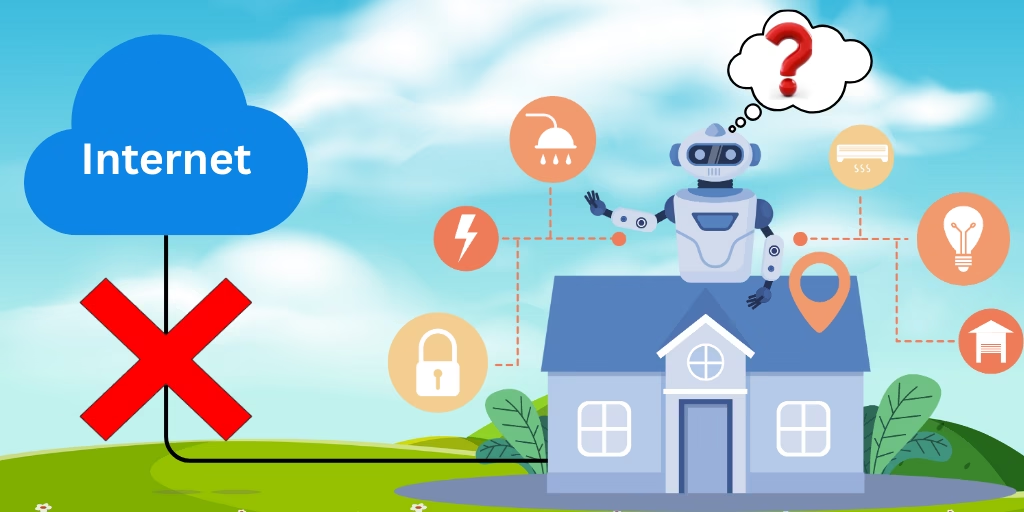What Happens to Your Smart Home When the Internet Goes Down
Smart home technology has been rapidly increasing in popularity over the last few years. A lot of smart home tech relies on having a reliable internet connection to work. But what happens when the internet connection goes down. This article explores the impact of loss of internet connectivity on your smart home and explains which smart functions will still work and which won’t and how to prepare for outages.
Internet Connectivity is The Backbone of a Smart Home
Many smart home devices, from lighting and heating systems to security cameras and voice assistants depend on a stable internet connection to communicate, receive commands, and interact with central servers in the cloud. When the connection goes down, the integration between these devices becomes disrupted. However, all is not lost, the degree of functionality loss depends on how the smart home system is designed and connected.
Local Versus Cloud Dependency
Devices with Local Control
Some smart home devices function on a local network even when the broader internet is unavailable. Hubs using protocols such as Zigbee, Z-Wave, or Bluetooth can maintain communication between devices without needing an external connection. For instance:
- Smart Lights and Switches: These may continue responding to pre set routines or manual commands from a local control panel, even if remote access from your smartphone is temporarily lost.
- Thermostats and Heating Controls: Many modern systems store user preferences locally, allowing temperature adjustments and routine heating schedules to run on autopilot, without the internet
- Outdoor Environmental Monitoring: Popular weather and environmental brands like Ecowitt can function locally, storing data on local storage on the gateway.
Cloud Dependent Smart Home Components
Conversely, many services rely heavily on cloud connectivity for real time data processing and functions
- Voice Assistants: Whether it’s Google Assistant, Amazon Alexa, or Siri, these devices require online servers to understand and process voice commands. Without internet access, their ability to control other smart devices or fetch information is severely limited.
- Remote Monitoring and Notifications: Security cameras, doorbells, and alarm systems need an active internet connection to stream live feeds or send alerts. When offline, these systems might still record locally (if equipped with SD card storage), but you lose real time access and notifications.
- Smart Home Apps and Routines: Automation that relies on cloud based triggers or remote monitoring will not work, meaning scheduled actions won’t kick and automation triggers won’t work.
- Smart Door Locks: Systems with onboard keypads, finger prints or physical overrides will remain accessible. Locks that use local connectivity like Bluetooth will continue to work using a smartphone. However, Smart locks that use Internet connectivity for remote access and management will stop working
The Impact on Automation and Daily Routines
Many households depend on the routines set up via automation apps. When the internet falls, these routines might run with limited capability:
- Scheduled Tasks: If your smart home is programmed to lower the blinds at a certain time or to adjust the thermostat when you leave for work, these functions often operate locally. However, any changes or updates that rely on internet based instructions will remain unresponsive until connectivity is re-established.
- Remote Control: Remotely access your smart home from a phone or web browser will no longer be possible.
- Automations: All automations will stop working. Even if all your smart devices are connected on the same local network, they will communicate with each other over the internet.
Safety, Security, and Backup Strategies
Smart home and security conscious homeowners should always plan for downtime. Here are several ways to mitigate the impact when the internet connection goes down:
- Invest in Local Hubs: A local smart home hub \ platform is the best way to to avoid relying on the internet for your smart home to work correctly. Examples of local smart home systems, include, Home Assistant, Homey, Hubitat, Homeseer. Choose smart devices that work with a central hub that supports local communication. This ensures that all functions, like lighting or heating controls, remain connected and automations and schedules will continue to work. Remote access away from the local network will not work, however if you smart phone or computer is connected to the local network they will be able to remotely access your smart home hub \ platform.
- Manual Overrides: Ensure that all essential systems (especially security features like door locks and alarm systems) offer manual overrides, Keys, Fingerprint access or physical keypads.
- Redundant Recording: For security cameras, opting for models with onboard storage safeguards your property by retaining footage even if remote access is lost.
- Test: Test offline functionality by unplugging your internet connection to be sure that your smart home can operate in ‘degraded mode’ until connectivity is re-established.
Conclusion
When the internet connection goes down, a smart home doesn’t have to go down. Devices that can communicate on a local network continue to function. For savvy homeowners and a bit of thought it is possible to minimise the impact of the internet going down. In fact, it is quite possible to have smart home that will not be effected at all by loss of internet.





